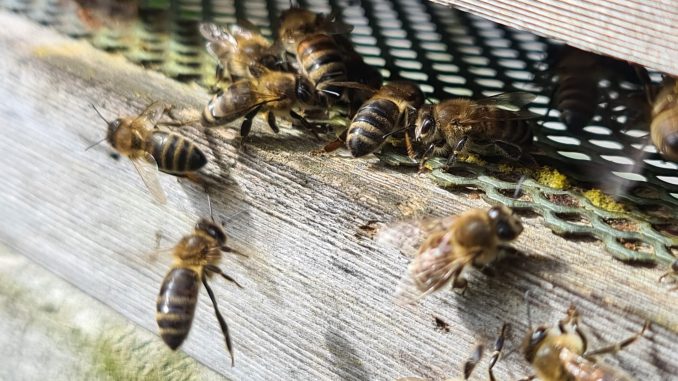
Some colonies have built up strongly and need plenty of super space if only to accommodate the bees! In spring I leave a super over the crown board as a precaution. It is amazing how quickly a colony can fill a super in ideal conditions so do check bees have enough super space.
It is now early May and some colonies have swarmed already. So we all need to check our bees regularly for queen cells.
There are 3 elements to consider when dealing with swarming: there is the queen, the flying bees and the brood. If one of these elements is removed it will stop a colony from swarming (or delay them).
The following is what we do with a conventional artificial swarm. The box containing the brood is moved to another spot in the apiary and the queen located. A new box containing drawn frames and some with foundation is placed on the original site and the queen returned. In this scenario the brood is removed and mimics a natural swarm. My preference is to place a frame of mainly sealed brood in with the queen so there are young bees coming through to look after and feed her.
So in the above by removing the brood we have prevented swarming.
If the queen cannot be found then we can carry out the same box arrangement as above but locate a frame with mainly eggs on it. Shake the bees off to make sure the queen is not on the frame. The bees can remain on the frame If you are certain the queen is not there. Place this frame in the box with foundation and drawn frames. Place a queen excluder over box and return a super (this provides stores as the brood box is mainly empty). If there are two or more supers I share them out between the two brood boxes. The bees will produce queen cells on the frame containing eggs – return to the hive a week or so later and leave one good looking queen cell. A new queen will emerge and eventually start laying in this box.
In this scenario we have removed the flying bees but the queen is still with the brood. The box with the queen will soon become active again so ensure it has super space if there is a flow.
The remaining option is to remove the queen and leave the brood and flying bees. In order to carry out this procedure it is preferable to use a nuc. Place the frame with the queen in the nuc and, if possible, another frame of mainly sealed brood. Give the nuc a couple of frames of stores and fill up the remaining space with either empty drawn comb or frames with foundation. As there is a laying queen the nuc can soon become congested so this needs to be monitored. Replace a frame of sealed brood if the nuc looks as if will become too crowded. Ideally move the nuc to another apiary as the flying bees will return to the original location.
Just a note when leaving a brood box containing just brood with queen cells as we need to knock down queen cells to prevent casts etc. It is good practice to knock down sealed queen cells as long as open ones are present containing a grub. Some people leave a single queen cell and others leave two as insurance. However, bees may swarm in this situation as the first queen to emerge will depart with the swarm leaving behind the other queen to take over the colony. How bees know if there is one or more queen cells is not something I can answer – that’s another bee mystery.
So there are many ways of dealing with swarming and other beekeepers will have variations on any of the above. Most importantly we are at the start of the swarming season now and good weather is forecast for a while. Bees no doubt will decide it is an ideal time to swarm so be prepared!
We will chat about swarming on Tuesday evening (May 10th) from 7.30pm on Zoom. An invitation will be sent out nearer the time and the session will be recorded.
